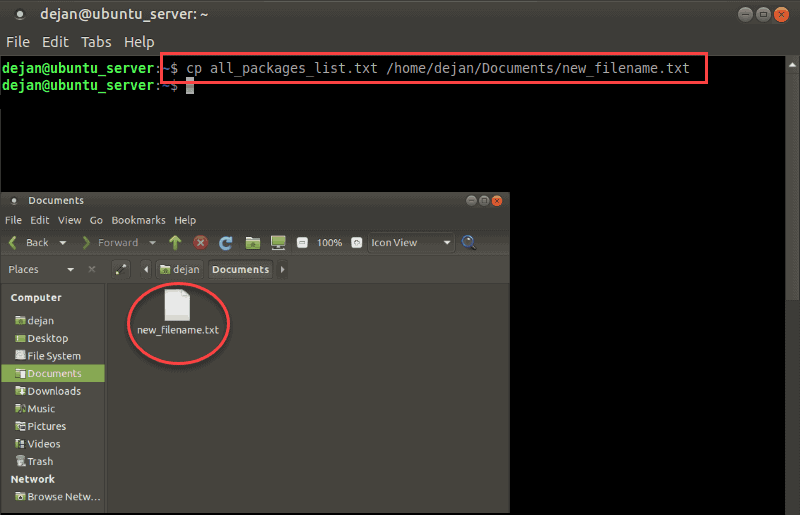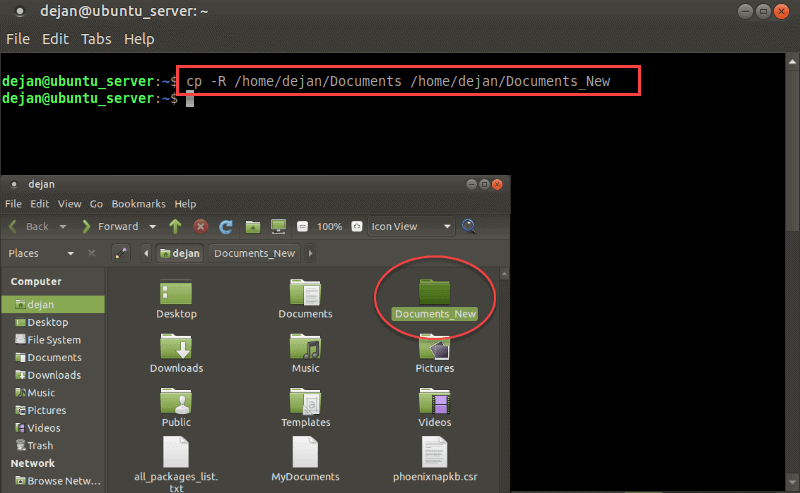How to Copy All Files From One Directory to Another in Linux
Introduction
This guide will show you how to copy files and directories in Linux by executing commands from the command line. Furthermore, the commands listed below detail how to create system-wide backups or filter out and copy only specific files.

Using the cp Command to Copy Files and Directories in Linux
The cp command is the primary method for copying files and directories in Linux. Virtually all Linux distributions can use cp . The basic format of the command is:
cp [additional_option] source_file target_file For example:
cp my_file.txt my_file2.txt This Linux command creates a copy of the my_file.txt file and renames the new file to my_file2.txt .
By default, the cp command runs in the same directory you are working in. However, the same file cannot exist twice in the same directory. You'll need to change the name of the target file to copy in the same location. Some users will add _old, some will add a number, and some will even change the three-letter extension (e.g., .bak instead of .txt).
You may not get a warning before Linux overwrites your file – be careful, or see below for the –i option.
Additional Options
Additional options can be used in combination with the cp command:
-
–vverbose: shows the progress of multiple copied files -
–ppreserve: keeps the same attributes, like creation date and file permissions -
–fforce: force the copy by deleting an existing file first -
–iinteractive: prompts for confirmation, highly advised -
–Rrecursive: copies all files and subfolders in a directory -
–uupdate: copy only if source is newer than destination
Note:The -p (preserve) option forces the system to preserve the following source file attributes: modification time, access time, user ID (UID), group ID (GID), file flags, file mode, access control lists (ACLs), and extended attributes (EAs).
How to Copy File to Another Directory in Linux
To copy a file from the directory you're working in to a different location, use the command:
cp my_file.txt /new_directory You don't need to rename the file unless there's already one with the same name in the target directory.
To specify a path for the source file:
cp /etc/my_file.txt /new_directory This lets you copy without having to change directories. The cp command will create the /new_directory if it doesn't exist.
To rename and copy a file to a different path:
cp my_file.txt /new_directory/my_file2.txt 
This option is useful for creating backups of configuration files, or for copying data to a storage device.
Copy Multiple Files from One Directory to Another in Linux
You may need to copy more than one file at a time.
List each file to be copied before the target directory:
cp my_file.txt my_file2.txt my_file3.txt /new_directory This example created a copy of all three files in the /new_directory folder.
Use a wildcard to specify all files that share a string of characters:
cp /pictures/*.jpg /new_directory This would find all the files with the .jpg extension in the /pictures directory, and copy them into the /new_directory folder.
To copy an entire folder and its subfolders and files, use the –R option:
cp –R /documents /new_directory 
–R stands for recursive, which means "everything in that location." This would copy all the files, as well as all the directories, to the /new_directory folder.
Copy Using rsync Command
The rsync command in Linux is used to synchronize or transfer data between two locations. Usage is similar to cp , but there are a few key differences to note.
To copy a single file, enter the following into a terminal:
rsync –a my_file.txt /new_directory/my_file_backup.txt - The
–aoption means all, and is included withrsynccommands – this preserves subdirectories, symbolic links, and other metadata. - Replace the my_file.txt file in the working directory.
- Replace /new_directory/ with the destination.
- Using my_file_backup.txt as the target indicates the file will be renamed during the copy.
To copy a directory with rsync, enter the following:
rsync –a /etc/docker/ /home/backup/docker/ This copies the contents of the /etc/docker/ directory to /home/backup/docker/. Make sure to keep the slashes. Omitting the slash on the source directory will copy the contents into a subdirectory.
To omit files from being copied, check out our guide on how to exclude files and directories in data transfer using rsync command.
Other Options
The ls command is a handy partner to the cp command in Linux.
To list the contents of a directory enter the command:
ls /directory The example above displays all the files in /directory. Use this command after copying to verify the files were copied successfully.
To change directories, use cd and the name of the directory. For example:
cd /other_directory The command prompt will change to display that you've changed directories.
Conclusion
Now you understand how to copy files in Linux. The cp command is a versatile and powerful tool for managing and backing up files.
Was this article helpful?
Yes No
How to Copy All Files From One Directory to Another in Linux
Source: https://phoenixnap.com/kb/how-to-copy-files-directories-linux